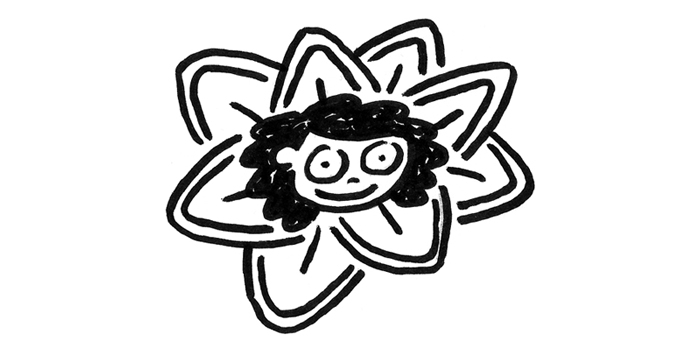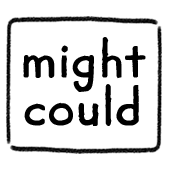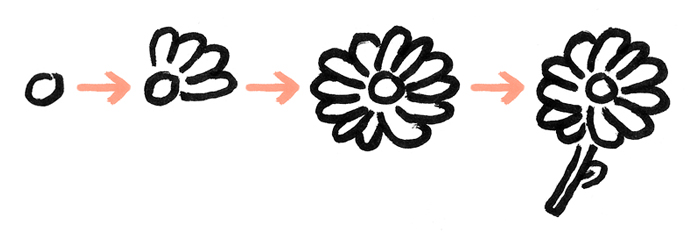
We all drew as children, uninhibited and imaginative. We absorbed all the artistic influences around us, from TV to movies to books. At some point, we decided to get better, and that’s when our artistic journey truly begins.
Whether self-taught or art-school-educated, most artists begin their journey focusing solely on the logical side of making art. These are the how-to, step-by-step, and lecture-based classes teaching perspective, tone, shading, anatomy, lighting, color science, etc. They cater to our intellectual, logical side of people—the side that likes categories, rules, and proven linear processes.

And I get it. Taking those classes is easier than floundering around haphazardly on the blank page. Those classes are popular because they cater to what people want: quick-fixes and simple solutions. Most people just want to be told exactly how to do something.
But learning to make your own original art doesn’t work that way.
This logical method of learning is helpful later on in our journey when we are more comfortable and confident as artists and ready to begin improving our craft and learning new techniques.
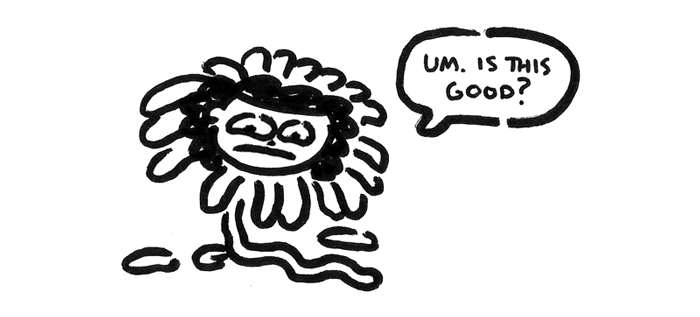
But this logical style of teaching will not help you when you are a budding artist. It won’t help you in the part of your journey when you don’t know who you are as an artist.
This part of the artistic journey is the most tumultuous and difficult. And I believe continuing to take logic-based courses when you don’t yet know how to make art in your own way, will actually hinder and impede your progress and growth as an artist.

Moving from Logical to Creative
We follow rules and copy from the logical part of our brain. But we don’t create new and original art from our logical side. We have to learn to tap into our other side—our creative side.
“Imagination is more important than knowledge.”
—Albert Einstein
Obviously, I like my way of drawing best, otherwise I’d be drawing in a different way. But that doesn’t mean it’s the best way for you. You are a different person, and you deserve the chance to make your own art.
The thing is, I can’t directly teach you how to make your art. No one can. We each only know how to make our own art. But in Sketchbook to Style, I wasn’t teaching students how to draw like me. I was teaching students to discover how to draw like them. And unknowingly to me, in doing that, what they were really learning was something deeper.
They were learning how to become artists.
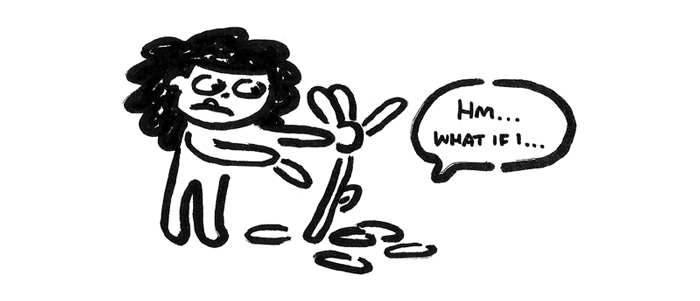
They were moving from the logical side of their brain to the creative side. The logical side can follow the steps of a tutorial, but this creative part of our brain is able to put things together that haven’t been put together before. It’s able to notice patterns and ideate. It’s able to play and experiment. It’s able to embrace ambiguity. It’s able to ignore their inner critic, make mistakes, go deep, and enjoy the process. It’s able to push past what is safe and has already been done before—it’s able to make original art.
Everyone’s journey to becoming an artist is unique and different. But there are common obstacles that pop up on everyone’s artistic journey. There is no shortcut, magic pill, or secret 3-step system, but I believe ****it’s possible to teach artistic discovery, by focusing on these common obstacles and the qualities we need to harness to overcome them.
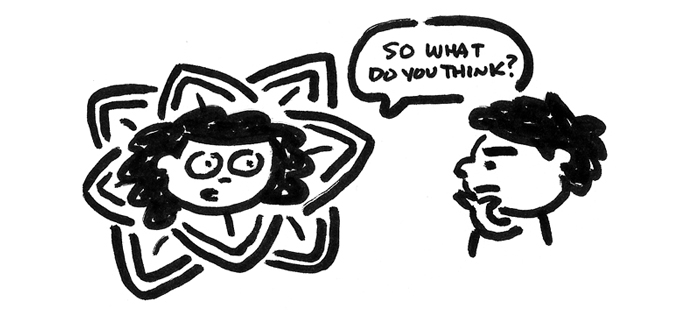
Obstacle: Self-Criticism + Judgment
I’ve developed what I believe to be the 15 obstacles and matching qualities that every artist faces on their artistic journey. Overcoming these obstacles allows us to move along the path from aspiring artist to producing artist.
For example, one common obstacle that budding artists encounter on their journey is being critical of their work too early on. They see where they are and where they want to be, and are hard on themselves for not being able to make the art they want to make right now. They make mistakes and draw things they’re unhappy with and beat themselves up with self-criticism.
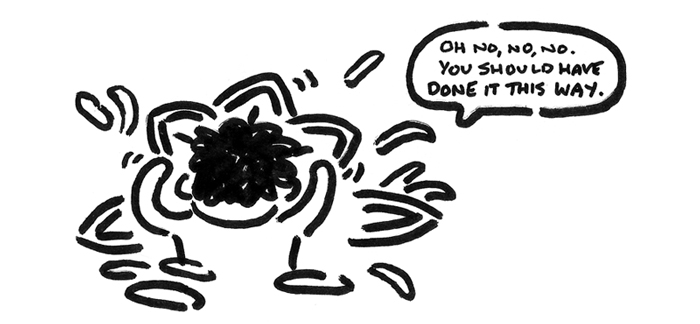
In addition to their inner critic, they often double-down on obstacles and look for external validation since they can’t provide it within. They show their early work to well-meaning teachers, parents, or peers, and often receive harsh, vague, and debilitating criticism.
Later on, feedback is helpful in pushing our art and progressing our skills, but early in the journey, most judgement and criticism like this more often leads to cutting us down instead of building us up.

Quality: Resiliency
Instead of getting stuck on this obstacle, budding artists need to harness their inner resilience. They need to learn that bad work and mistakes are a necessary and essential part of the process—and that they can bounce back from them. That we can’t aim for perfection, but instead need to focus on growth. We need to accept that our work will be awkward and embarrassing for some time. We have to be willing to be bad. We have to persist.
Early work should be celebrated instead of just searched for weaknesses. Letting ourselves stay in an analytical, critical mindset is crippling to the early stages of creation.
We need to learn to be audacious and bold in our art, not scared of mistakes. We need to be willing to try and fail and experiment. We need to focus on making art, not ripping it up.
Of course, later in the journey, we should look at our work with a critical eye to continuously improve our craft and abilities. But early in our journey is not the time. First we have to learn to harness our inner resiliency so we can withstand and respond to the critique instead of breaking down and giving up.

The Artist’s Journey
Following tutorials on how to draw human anatomy or 3-point perspective might teach you how to do those things, but they won’t teach you how to become an artist. Instead of taking tutorial after tutorial, being told what they should be doing and how to do it, artists instead need an overarching framework to guide them to a more creative way of thinking.
Based on what I’ve learned, I’ve developed a framework to propel aspiring artists from stage to stage through this artistic journey. This framework is built around the common obstacles we all face and teaches how to adopt the matching qualities to overcome them.
But the framework just part of the puzzle. I’ve discovered that in order to continue moving along our journey, we often need an extra push—we need encouragement and support.

Accelerating Through the Journey
Aspiring artists need to have their early artistic attempts celebrated, regardless of how “successful” they are deemed by the artist or others. We don’t yet know what “successful” means to their art, and they have to figure that out. And the only way to discover that is to explore and experiment and keep making more art.
The aspiring artist doesn’t need someone to show them how to make their art. They need a supportive community that will make art with them. They need nurturing, encouragement, and the support of other artists who understand the obstacles they’re facing. They need a group of fellow artists to believe in them, so they can believe in themselves.
Most aspiring artists never get this early support. And so, most aspiring artists never progress from that point, forever calling themselves Aspiring Artists.
I don’t want that to happen to anyone. My mission is to help you become an artist. I don’t want you to quit. And I don’t want you to be unhappy with your art. I want you to develop and grow and blossom into the artist you’ve always strived to be.
Because we all face these same obstacles, and we all have these artistic qualities within us waiting to be unleashed. Together, we can make our art. Together, we can be artists.
